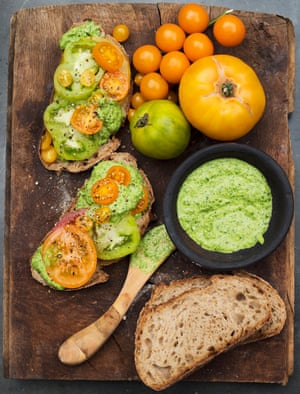With the autumn glut comes a final chance to enjoy homegrown tomatoes as the main event in stews and curries.
It
is now, as the summer dips into autumn, that tomatoes are at their
best. They are the last few hauls of home-grown fruit before the plants
wither to a crisp and head off to the compost. A bit of a mixed bag to
be honest, but I like that. The chance to match up the tiny Sungold,
Green Zebra and those fat yellow fruits with their flash of carmine. The
opportunity to marry the sharp with the oversweet, the pear with the
cherry, the green with those on the verge of collapse. All comers are
welcome.
I threw odds and sods from the trays at the greengrocer’s at a
vegetable stew last week, spicing the rust-coloured slush with chilli,
turmeric and garlic, then stirring in a spoonful of sticky tamarind
paste to give a lift to the pervading late-summer sweetness. I griddled
courgettes, currently cheap as chips, and added them at the last minute
so they kept some texture. We passed the big bowl along the table, a
last meal in the dying sun, everyone dipping into rice studded with
cloves and cumin seeds, then spooning over the spiced tomato stew.
I like the way bread soaks up the tomato’s juices, be it in an
Italian pappa al pomodoro, the soft-textured soup-salad; a Provençal pan
bagnat (more tomatoes than tuna for me, please) or a simple breakfast
of grilled tomatoes on white toast, the edges of the bread smoked from
the grill, then soaked with tart juice. I made a plate of sandwiches
this week, too, making first a basil, olive oil and garlic paste to use
in lieu of butter. Better, I think, was the one I made later using
coriander, chillies and yogurt – a sort of fresh chutney really.
A pinch of sugar will sort out any end-of-season fruits that let you
down. Add it with the salt and black pepper. Even the meanest shake of
caster will do more than you might imagine. I like to bake a dish of
halved fruits of all shapes and sizes, their surfaces spread with a
loose dressing of garlic, olive oil, a splash of red wine vinegar, a
pinch of sugar and a fistful of mixed fresh herbs. The trick is to make
the paste runny enough to baste the tomatoes as they roast, and have
something under them to mop up the juices – a raft of toast or
flatbread, or a slice of focaccia. It’s the tomato’s final fling.
Courgettes and spiced tomatoes
A curry, of sorts. The turmeric adds its characteristic earthy note,
the tamarind paste a welcome, mellow sourness. There is heat, too, from
the chillies and mustard seeds, but the overall effect is light, bright
and sweet-sharp. Rice – steamed with a chopped shallot, a few cloves, a
bay leaf or two and its snow-white depths freckled with cumin seeds – is
a given.
Serves 4
groundnut oil 2 tbsp
cumin seeds 1 tsp
yellow mustard seeds 1 tsp
onion 1, medium
hot green chilli 1, small
cherry tomatoes 700g
tamarind paste ½ tsp
ground turmeric 1 tsp
chilli powder ½ tsp
courgettes 6, medium
steamed rice to serve
Warm the groundnut oil in a shallow pan, then add the cumin and
mustard seeds and cook for a minute or two till fragrant. Peel and
finely chop the onion then add it to the spices, together with the
finely chopped green chilli. Stirring regularly, let the onion cook for 5
to 10 minutes, until translucent.
Halve the tomatoes and drop them into a bowl, then combine with the
tamarind paste, ground turmeric and chilli powder, mashing it all
together with a wooden spoon. When the onion has softened but before it
starts to change colour, stir in the tomatoes and a little salt,
partially cover with a lid and simmer for about 20 minutes until the
tomatoes have collapsed into a rough, scarlet sauce.
Slice the courgettes into short lengths, about 4 or 5 to each fruit,
then cook on a griddle until lightly browned on the outside.
(Alternatively you can fry them in a shallow pan with a little olive
oil.) Transfer the browned courgettes to the spiced tomato and simmer
for a further 10 minutes until each piece is fully tender.
Serve with the steamed rice.
Tomato sandwich with coriander paste
I often use cucumber or a cool salad leaf as well as the tomato.
Avoid rocket and watercress which add too much heat, and go instead for
cooling leaves, such as little gem, iceberg or butterhead lettuce.
Makes 2 large sandwiches.
For the sandwiches:
sourdough, white or rye bread 4 slices
tomatoes 250g, assorted sizes
coriander paste see below
For the paste:
coriander 70g
lime juice 2 tbsp
sugar ½ to 1 tsp
green chillies 1-2, small
ginger a 70g piece
natural yogurt 6-7 tbsp
Remove the leaves from the coriander. Put the lime juice, sugar,
chilli (one or both, depending on your heat threshold), ginger (peeled
and roughly sliced) and the yogurt into the jug of a blender and process
to a coarse paste. Add the coriander leaves and a little salt and
process further. The paste should be pungent, slightly citrus, sour and
hot. Add sugar, yogurt or more lime juice to taste.
Slice the tomatoes thinly. Spread each piece of bread generously with
some of the coriander paste, then place the tomato slices on top. Place
a piece of the spread bread on top and press down lightly. Store any
leftover paste, covered, in the fridge.














